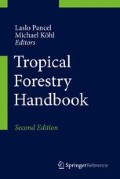Abstract
A main character of the entire tropics are the very low longitudinal gradients of air temperature of only 1 °C/1,000 km. In Fig. 1 (above) this is indicated by the broad reddish sector around the equator between 30°N and S and even beyond. A closer look at the upper image reveals darker patterns and hence the globally “hottest ecozone” over the Sahel and southern Sahara to the SE of the Arabian Peninsula. By far most of this section is part of the outer tropics. This “heat crest” north of the equator represents a thermal asymmetry and is linked to the large dimension of landmass in the northern half of Africa. Vertical termperature gradients in tropical mountains as well as changing meridional gradients of temperature amplitudes between the outer and inner tropics are presented by Figs. 2 and 3, resp. Diurnal an seasonal cycles are illustrated by thermoisopleths for different altitudes and under arid up to perhumid conditons (Figs. 4 and 5), which are also exampled for soil and surface temperatures (Fig. 6). Impacts of cold as well as of dry air intrusions (Figs. 7–9) are related to plant reactions and phenological aspects (Fig. 10).
Access this chapter
Tax calculation will be finalised at checkout
Purchases are for personal use only
References
Bendix J, Lauer W (1992) Die Niederschlagsjahreszeiten in Ecuador und ihre klimadynamische Interpretation. Erdkunde 46:118–134. doi:10.3112/erdkunde.1992.02.04
Bendix J, Rafiqpoor D (2001) Studies on the thermal conditions of soils at the upper tree line in the páramos of Papallacta (Eastern Cordillera of Ecuador). Erdkunde 55:257–276
Cueva OE, Homeier J, Breckle SW, Bendix J, Emck P, Richter M, Beck E (2006) Seasonality in an evergreen tropical mountain rainforest in southern Ecuador. Ecotropica 12:69–85
Emck P (2007) A climatology of south Ecuador. With special focus on the major Andean ridge as Atlantic-pacific climate divide. PhD thesis. University of Erlangen-Nuremberg, Erlangen. Available at: http://www.opus.ub.uni-erlangen.de/opus/volltexte/2007/656/. Accessed 2 Dec 2013
Garreaud R (2001) Subtropical cold surges: regional aspects and global distribution. Int J Climatol 21:1181–1197. doi:10.1002/joc.687
http://upload.wikimedia.org/wikipedia/commons/b/b3/MonthlyMeanT.gif
http://www.globalwarmingart.com/wiki/File:Annual_Average_Temperature_Map_jpg
Lauer W (1973) Zusammenhänge zwischen Klima und Vegetation am Ostabfall der Mexikanischen Meseta. Erdkunde 27:192–213
Lauer W (1993) Climatology. In: Pancel L (ed) Tropical forestry handbook, vol 1. Springer, Berlin/New York, pp 96–164
Marengo J, Cornejo A, Satyamurty P, Nobre CA, Sea W (1997) Cold waves in the south American continent. The strong event in june 1994. Mon Weather Rev 125:2759–2786
Richter M (1996) Klimatologische und pflanzenmorphologische Vertikalgradienten in Hochgebirgen. Erdkunde 50:205–237
Richter M (2003) Using epiphytes and soil temperatures for eco-climatic interpretations in southern Ecuador. Erdkunde 57:161–181. doi:10.3112/erdkunde.2003.03.01
Rollenbeck R (2010) Global sources – local impacts: natural and anthropogenic matter deposition in the Andes of Ecuador. Geophys J Roy Astron Soc 31:5–27
Troll C, Paffen KH (1964) Karte der Jahreszeiten-Klimate der Erde. Erdkunde 18:5–28
Walter H, Medina E (1969) Die Bodentemperatur als ausschlaggebender Faktor für die Gliederung der subalpinen und alpinen Stufe in den Anden Venezuelas. Ber Dtsch Bot Ges 82:275–281
Winiger M (1981) Zur thermisch-hygrischen Gliederung des Mount Kenia. Erdkunde 35:248–263
Author information
Authors and Affiliations
Corresponding author
Editor information
Editors and Affiliations
Rights and permissions
Copyright information
© 2016 Springer-Verlag Berlin Heidelberg
About this entry
Cite this entry
Richter, M. (2016). Temperatures in the Tropics. In: Pancel, L., Köhl, M. (eds) Tropical Forestry Handbook. Springer, Berlin, Heidelberg. https://doi.org/10.1007/978-3-642-54601-3_38
Download citation
DOI: https://doi.org/10.1007/978-3-642-54601-3_38
Publisher Name: Springer, Berlin, Heidelberg
Print ISBN: 978-3-642-54600-6
Online ISBN: 978-3-642-54601-3
eBook Packages: Biomedical and Life SciencesReference Module Biomedical and Life Sciences

